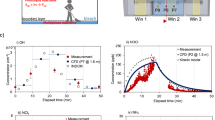Abstract
This study focuses on the variability in chemical exposures for individuals working in office buildings. The study involved eight office buildings with 79 participants, and exposures were measured using personal samplers for volatile organic compounds, aldehydes, amines, nitrogen dioxide, ozone, and particles. Ventilation was assessed in each individual office. “Variability among buildings” and “variability among individuals” were evaluated for any component (of the 123) measured in samples from at least 20 persons, using variance component analysis and principal component analysis. Interpersonal differences explained the major part of the variance for 78% of the compounds versus between-buildings differences for 14% of the compounds. For 8% of compounds, the variation was explained in equal amounts by the differences among individuals and among buildings. This study illustrates the necessity for individualised measurements (versus stationary measurements in building) to estimate personal exposures. These results also support the conculsion that in case-referent studies of “sick building syndrome” (SBS), referents to SBS cases can be randomised for building location.
This is a preview of subscription content, access via your institution
Access options
Subscribe to this journal
Receive 6 print issues and online access
$259.00 per year
only $43.17 per issue
Buy this article
- Purchase on SpringerLink
- Instant access to full article PDF
Prices may be subject to local taxes which are calculated during checkout




Similar content being viewed by others
References
AFS. 2000 Hygieniska gränsvärden och åtgärder mot luftföroreningar, Solna, Arbetarskyddsstyrelsens författningssamling, 2000; p. 3.
Andersson B., and Andersson K. Determination of tertiary amines in air. Appl Ind Hygiene 1989: 4: 175–179.
Angell W.J., and Grimsrud D.T. Establishing indoor air quality research priorities. Proceedings Indoor Air 2002, Vol. 2, Monterey, CA, 2002, pp. 972–977.
ASHARE Standard 62. 1999. Ventilation for Acceptable Indoor Air Quality, American Society of Heating, Refrigerating and Air-Condition Engineers, Inc. Atlanta, GA, 1999.
Atkinson R., Tuazon E.C., and Aschmann S.M. Products or the gas-phase reactions of O3 with alkenes. Environ Sci Technol 1995: 29: 1860–1866.
Bornehag C.G., Blomquist G., Gyntelberg F., Järvholm B., Malmberg P., Nordvall L., Nielsen A., Pershagen G., and Sundell J. Dampness in buildings and health. Nordic interdisciplinary review of the scientific evidence on associations between exposure to “dampness” in buildings and health effects (NORDDAMP). Indoor Air 2001: 11: 72–86.
Box G.E.P., Hunter W.G., and Hunter J.S. Statistics for Experimenters. John Wiley & Sons, New York, 1978 (ISBN 0-471-09315-7).
Carlson R. Design and Optimization in Organic Synthesis. Elsevier, Amsterdam, 1992.
Dingle P., Tapsell P., and Hus S. Reducing formaldehyde exposure in office environments using plants. Bull Environ Contamination Toxicol 2000: 64: 302–308.
Eriksson L., Johansson E., and Kettaneh-Wold N., et al. Multi- and Megavariate Data Analysis. Principles and Applications. Umetrics Academy, Umeå, 2001 (ISBN 91-873730-1-X).
Fenske J.D., and Paulson S.E. Human breath emissions of VOCs. J Air Waste Mngt Assoc 1999: 49: 594–598.
Ferm M. Validation of a Diffusive Sampler for Ozone. Abstract Book from International Conference Measuring Air Pollutants by Diffusive Sampling. Montpellier, France, 2001, p. 71.
Hagenbjörk-Gustafsson A., Lindahl R., and Levin J.-O., et al. Validation of a diffusive sampler for NO2 . J Environ Monitoring 1999: 1: 349–352.
Hauschildt P., Mølhave L., and Kjærgaard S.K. Reactions or healthy persons and persons suffering from allergic rhinitis when exposed to office dust. Scand J Work Environ Health 1999: 25: 442–449.
Hodgson M.J., Frohliger J., Permar E., Tidwell C., Traven N.D., Olenchock S.A., and Karpf M. Symptoms and microenvironmental measures in nonproblem buildings. J Occup Med 1991: 33: 527–533.
Jones A.P. Indoor air quality and health. Atmospheric Environ 1999: 33: 4535–4564.
Kemp P.C., Dingle P., and Neumeister H.G. Particulate matter intervention study: a causal factor of building-related symptoms in an older building. Indoor Air 1998: 8: 153–171.
Levin J.-O., Lindahl R., and Andersson K. High performance liquid chromatographic determination of formaldehyde in air in the ppb to ppm range using diffusive sampling and hydrazone formation. Environ Technol Lett 1988: 9: 1423–1430.
Liljelind I.E., Rappaport S.M., and Levin J.-O., et al. Comparison of self- and expert assessment of occupational exposure to chemicals. Scand J Work Environ Health 2001: 27: 311–317.
Liljelind I.E., Strömbäck A., and Järvholm B., et al. Self assessment of exposure — a pilot study of assessment of exposure to benzene in tank truck drivers. Appl Environ Occupational Health 2000: 15: 195–202.
Lindahl R., Levin J.-O., and Andersson K. Determination of volatile amines in air by diffusive sampling, thiourea formation and high-performance liquid chromatography. J Chromatography 1993: 643: 35–41.
Pan Z., Mølhave L., and Kjærgaard S.K. Effects on eyes and nose in humans after experimental exposure to airborne office dust. Indoor Air 2000: 10: 237–245.
Plant N.T., and Wright M.D. European diffusive sampling initiative: confirmation of BTX uptake rates. UK Health and Safety Executive Report, Ref. OMS/99/07, 1999.
Pommer L., Fick J., and Andersson B., et al. Class separation of buildings with high and low prevalence of SBS by principal component analysis. Indoor Air 2004: 14: 16–23.
Redlish C.A., Sparer J., and Cullen M.R. Sick-building syndrome. Lancet 1997: 349: 1013–1016.
Schneider T., Sundell J., Bishof W., Bohgard M., Cherrie J.W., Clausen P.A., Dreborg S., Kildesø J., Kjærgaard S.K., Løvik M., Pasanen P., and Skyberg K. “EUROPART”. Airborne particles in the indoor environment. A European interdisciplinary review of scientific evidence on associations between exposure to particles in buildings and health effects. Indoor Air 2003: 13: 38–48.
Stenberg B. Office illness — the worker, the work and the workplace. Umeå University Medical Dissertation, Umeå, 1994.
Sunesson A.-L., Gullberg J., and Blomquist G. Airborne chemical compounds on dairy farms. J Environ Monitoring 2001: 3: 210–216.
Sunesson A.-L., Gullberg J., and Olsson-Köhler K., et al. Multivariate evaluation of VOCs in homes and office buildings with and without known SBS complaints. Proceedings Indoor Air 2002, Vol. 4, Monterey, CA, 2002, pp. 84–89.
Ten Brinke J., Selvin S., and Hodgson A.T., et al. Development of a new volatile organic compound (VOC) exposure metrics and their relationship to “sick building syndrome” symptoms. Indoor Air 1998: 8: 140–152.
Weschler C.J. Ozone in indoor environments: concentrations and chemistry. Indoor Air 2000: 10: 269–288.
WHO. Indoor air pollutants: exposure and health effects. EURO Reports and Studies 78, World Health Organisation, Copenhagen, 1983.
WHO. Air Quality Guidelines. World Health Organisation, Geneva, 1999 (http://www.who.int/environmental_information/Air/Guidelines/Chapter3.htm).
Wold S., Eriksson L., and Sjostrom M. PLS in Chemistry. Encyclopedia Computational Chemistry. Wiley, New York, 1998.
Wolkoff P., and Nielsen G.D. Organic compounds in indoor air — their relevance for perceived indoor air quality. Atmospheric Environment 2001: 35: 4407–4417.
Wolkoff P., Wilkins C.K., and Clausen P.A., et al. Comparison of volatile organic compounds from processed paper and toners from office copiers and printers: methods, emission rates and modelled concentrations. Indoor Air 1993: 3: 113–123.
Wright M.D. Diffusive uptake rates for the Perkin–Elmer tube — BCR ir sampling intercomparisons at Vito (Mol, Belgium) February 1991 – April 1992. UK Health and Safety Executive Report, Ref. IR/L/IA/93/3, 1993.
Zhang J., He Q., and Lioy P.J. Characteristics of aldehydes: concentrations, sources and exposures for indoor and outdoor residential microenvironments. Environ Sci Technol 1994: 28: 146–152.
Acknowledgements
Financial support for this project from Vårdalstiftelsen and the Centre for Environmental Research (CMF) is gratefully acknowledged. We thank Margit Sundgren, Margaret Rhén, Annika Hagenbjörk-Gustafsson, and Lissi Thomasson for skilful technical assistance, and Ingrid Liljelind for the illustrations used in the informational material for the participants. This study has been approved by the ethical committee of Umeå University, dnr 00-101.
Author information
Authors and Affiliations
Corresponding author
Rights and permissions
About this article
Cite this article
Glas, B., Levin, JO., Stenberg, B. et al. Variability of personal chemical exposure in eight office buildings in Sweden. J Expo Sci Environ Epidemiol 14 (Suppl 1), S49–S57 (2004). https://doi.org/10.1038/sj.jea.7500358
Published:
Issue date:
DOI: https://doi.org/10.1038/sj.jea.7500358
Keywords
This article is cited by
-
Exposure to formaldehyde, nitrogen dioxide, ozone, and terpenes among office workers and associations with reported symptoms
International Archives of Occupational and Environmental Health (2015)
-
Passive dosimeters for nitrogen dioxide in personal/indoor air sampling: A review
Journal of Exposure Science & Environmental Epidemiology (2008)



